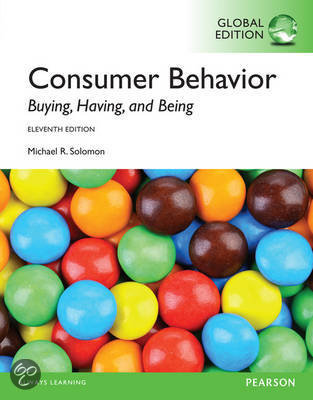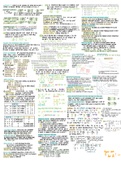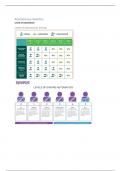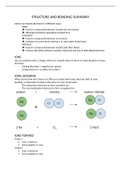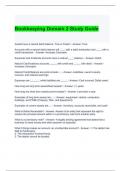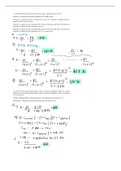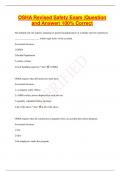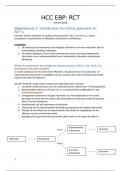Consumer Behavior summaries
Chapter 1: Buying, Having and Being: An introduction to consumer
behavior
What is consumer behavior?
It is the study of the processes involved when individuals or groups select, purchase,
use or dispose of products, services, ideas or experiences to satisfy their needs and
desire.
Consumer behavior includes everything in the consumption process; before, during
and after the purchase.
The Exchange: A transaction in which two or more organizations or people give and
receive something of value
A consumer: A person who identifies a need or desire, makes a purchase and then
dispose the product during the three stages of the consumption process.
Consumers impact on marketing strategy
Heavy users: consumers who purchase the most of a certain brand
80/20 rule: 20 percent of the Users account for 80 percent of the sales
Marketers have to understand the wants and needs of different consumer segments!
Demographic aspects to divide consumers:
• Age
• Gender
• Family structure
• Social class/ Income
• Race and Ethnicity
• Geography
• Lifestyles
1
,Segmenting by Behavior: Relationships and Big Data
Relationship marketing: building a relationship between customers and brands that
will last a lifetime. Interaction with customers on a regular basis and giving solid
reasons to maintain the bond.
Database Marketing: tracks specific consumers’ buying habits and crafts products
and massages specifically tailored to peoples wants and needs based on this
information.
Big Data: the collection and analysis of extremely large data sets.
Marketing’s impact on consumers
Our choices as consumers relate in powerful ways to the rest of our lives.
Popular culture: the music, movies, celebrities, sports, books and other forms of
entertainment that the mass market produces and consumes.
Role theory: much of consumer behavior resembles actions in a play. Because
people act out many different roles, they sometimes alter their consumption decisions
depending on the particular “play” they are in at the time.
Relationships between products and consumers:
Self-concept attachment- The product helps to establish the users identity
Nostalgic attachment – The product serves as a link with a past self
Interdependence – The product is part of the users daily routine
Love – The product elicits emotional bonds of warmth, passion, or other strong
emotions
What does it mean to consume?
Our motivations to consume are complex and varied.
People often buy products not for what they do but for what they mean.
Brand images: meanings that have been carefully crafted. So when you buy the
product you are buying more than the product itself, you buy a lifestyle that you have
or that you wish to have.
What is the difference between needing something and wanting it?
A need is something a person must have to live or achieve a goal.
A want is a specific manifestation of a need that personal and cultural factors
determine.
The global “always-on” consumer
Technology and culture create a new “always-on” consumer.
Megacity: a metropolitan area with a total population of more than 10 million people.
2
,The digital Native living a social [media] life
Digital revolution is one of the most significant influences on consumer behavior.
Electronic marketing makes our lives a lot easier, we can shop 24/7 without leaving
the home.
B2C e-commerce: Businesses selling to consumers.
C2C e-commerce: consumer to consumer activities. Virtual brand-communities, just
as shopping is not limited to local retailers, communities aren’t either.
Digital Natives: a new type of student, these consumers grew up ”wired” in a highly
networked, always-on world.
Net neutrality: ensures that everyone- individual users and behemoth companies –
is guaranteed equal access to the pipes we rely on to access cyberspace.
Synchronous interactions: those that occur in real time, like when you text back
and forth
Asynchronous interactions: those that don’t require all participants to respond
immediately
Consumer behavior as a field of study
Many different types of specialists study consumer behavior.
You can find people with training in a wide range of disciplines from psychophysiology to
literature doing consumer research. Universities, manufacturers, museums, advertising
agencies, and governments employ consumer researchers.
3
, The fields closer to the top of the
pyramid concentrate on the
individual consumer (micro
issues), and those toward the
base are more interested in the
collective activities that occur
among larger groups of people,
such as consumption patterns
members of a culture or
subculture share (macro issues).
Two perspectives on consumer behavior
There are differing perspectives regarding how and what we should understand about
consumer behavior.
Paradigm: A set of beliefs that guide our understanding of the world
Some belief that there is a shift in paradigms from positivism towards interpretivism.
Positivism: human reason is supreme and that there is a single, objective truth that science
can discover.
Interpretivism: questions the assumptions of positivism, we emphasize science and
technology too much and they feel that this order, rational view of behavior denies or ignores
the complex social and cultural world in which we really live.
4
Chapter 1: Buying, Having and Being: An introduction to consumer
behavior
What is consumer behavior?
It is the study of the processes involved when individuals or groups select, purchase,
use or dispose of products, services, ideas or experiences to satisfy their needs and
desire.
Consumer behavior includes everything in the consumption process; before, during
and after the purchase.
The Exchange: A transaction in which two or more organizations or people give and
receive something of value
A consumer: A person who identifies a need or desire, makes a purchase and then
dispose the product during the three stages of the consumption process.
Consumers impact on marketing strategy
Heavy users: consumers who purchase the most of a certain brand
80/20 rule: 20 percent of the Users account for 80 percent of the sales
Marketers have to understand the wants and needs of different consumer segments!
Demographic aspects to divide consumers:
• Age
• Gender
• Family structure
• Social class/ Income
• Race and Ethnicity
• Geography
• Lifestyles
1
,Segmenting by Behavior: Relationships and Big Data
Relationship marketing: building a relationship between customers and brands that
will last a lifetime. Interaction with customers on a regular basis and giving solid
reasons to maintain the bond.
Database Marketing: tracks specific consumers’ buying habits and crafts products
and massages specifically tailored to peoples wants and needs based on this
information.
Big Data: the collection and analysis of extremely large data sets.
Marketing’s impact on consumers
Our choices as consumers relate in powerful ways to the rest of our lives.
Popular culture: the music, movies, celebrities, sports, books and other forms of
entertainment that the mass market produces and consumes.
Role theory: much of consumer behavior resembles actions in a play. Because
people act out many different roles, they sometimes alter their consumption decisions
depending on the particular “play” they are in at the time.
Relationships between products and consumers:
Self-concept attachment- The product helps to establish the users identity
Nostalgic attachment – The product serves as a link with a past self
Interdependence – The product is part of the users daily routine
Love – The product elicits emotional bonds of warmth, passion, or other strong
emotions
What does it mean to consume?
Our motivations to consume are complex and varied.
People often buy products not for what they do but for what they mean.
Brand images: meanings that have been carefully crafted. So when you buy the
product you are buying more than the product itself, you buy a lifestyle that you have
or that you wish to have.
What is the difference between needing something and wanting it?
A need is something a person must have to live or achieve a goal.
A want is a specific manifestation of a need that personal and cultural factors
determine.
The global “always-on” consumer
Technology and culture create a new “always-on” consumer.
Megacity: a metropolitan area with a total population of more than 10 million people.
2
,The digital Native living a social [media] life
Digital revolution is one of the most significant influences on consumer behavior.
Electronic marketing makes our lives a lot easier, we can shop 24/7 without leaving
the home.
B2C e-commerce: Businesses selling to consumers.
C2C e-commerce: consumer to consumer activities. Virtual brand-communities, just
as shopping is not limited to local retailers, communities aren’t either.
Digital Natives: a new type of student, these consumers grew up ”wired” in a highly
networked, always-on world.
Net neutrality: ensures that everyone- individual users and behemoth companies –
is guaranteed equal access to the pipes we rely on to access cyberspace.
Synchronous interactions: those that occur in real time, like when you text back
and forth
Asynchronous interactions: those that don’t require all participants to respond
immediately
Consumer behavior as a field of study
Many different types of specialists study consumer behavior.
You can find people with training in a wide range of disciplines from psychophysiology to
literature doing consumer research. Universities, manufacturers, museums, advertising
agencies, and governments employ consumer researchers.
3
, The fields closer to the top of the
pyramid concentrate on the
individual consumer (micro
issues), and those toward the
base are more interested in the
collective activities that occur
among larger groups of people,
such as consumption patterns
members of a culture or
subculture share (macro issues).
Two perspectives on consumer behavior
There are differing perspectives regarding how and what we should understand about
consumer behavior.
Paradigm: A set of beliefs that guide our understanding of the world
Some belief that there is a shift in paradigms from positivism towards interpretivism.
Positivism: human reason is supreme and that there is a single, objective truth that science
can discover.
Interpretivism: questions the assumptions of positivism, we emphasize science and
technology too much and they feel that this order, rational view of behavior denies or ignores
the complex social and cultural world in which we really live.
4

